Mitsubishi Motors Bundle
How has Mitsubishi Motors navigated the ever-changing automotive landscape?
From its roots in 1870s Japan, Mitsubishi Motors has evolved from a shipping enterprise to a global automotive powerhouse. This Mitsubishi Motors SWOT Analysis will help you understand the company. Its journey showcases remarkable adaptability and a commitment to innovation within the competitive automotive industry.
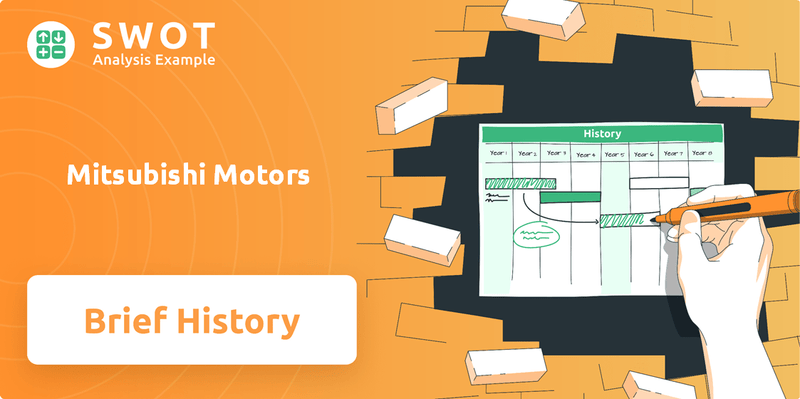
The Mitsubishi company story is a compelling narrative of resilience and strategic foresight. Tracing the Mitsubishi history reveals a company that consistently embraced technological advancements and adapted to global market dynamics. Understanding the Mitsubishi Motors journey provides valuable insights into the evolution of a Japanese car manufacturer and its enduring impact on the automotive industry.
What is the Mitsubishi Motors Founding Story?
The story of Mitsubishi Motors begins with the broader Mitsubishi zaibatsu, founded in 1870 by Yataro Iwasaki. This Japanese conglomerate's roots are deeply intertwined with Japan's modernization and industrial growth. Understanding the origins of Mitsubishi is crucial to grasping the evolution of the Japanese car manufacturer.
Yataro Iwasaki, a former samurai, started in shipping, aiming to modernize Japan's maritime transport during the Meiji Restoration. His initial venture, Tsukumo Shokai, later became Mitsubishi Mail Steamship Company in 1873, marking the official start of the Mitsubishi organization. The name 'Mitsubishi' itself is derived from 'mitsu' (three) and 'hishi' (water chestnut, or rhombus), reflecting the company's iconic three-diamond logo.
The early Mitsubishi organization focused on shipping but quickly diversified into mining, shipbuilding, banking, and trading. This diversification was crucial for supporting the core shipping business and contributing to Japan's modernization. This strategic approach laid the foundation for future ventures, including the eventual entry into the automotive industry.
Mitsubishi's journey began with shipping and expanded into various sectors, setting the stage for its automotive ambitions.
- Yataro Iwasaki founded the Mitsubishi zaibatsu in 1870.
- The company's logo, the three diamonds, symbolizes its heritage.
- Mitsubishi diversified into multiple industries to support its core businesses.
- The company's early focus was on contributing to Japan's modernization.
Mitsubishi Motors SWOT Analysis
- Complete SWOT Breakdown
- Fully Customizable
- Editable in Excel & Word
- Professional Formatting
- Investor-Ready Format
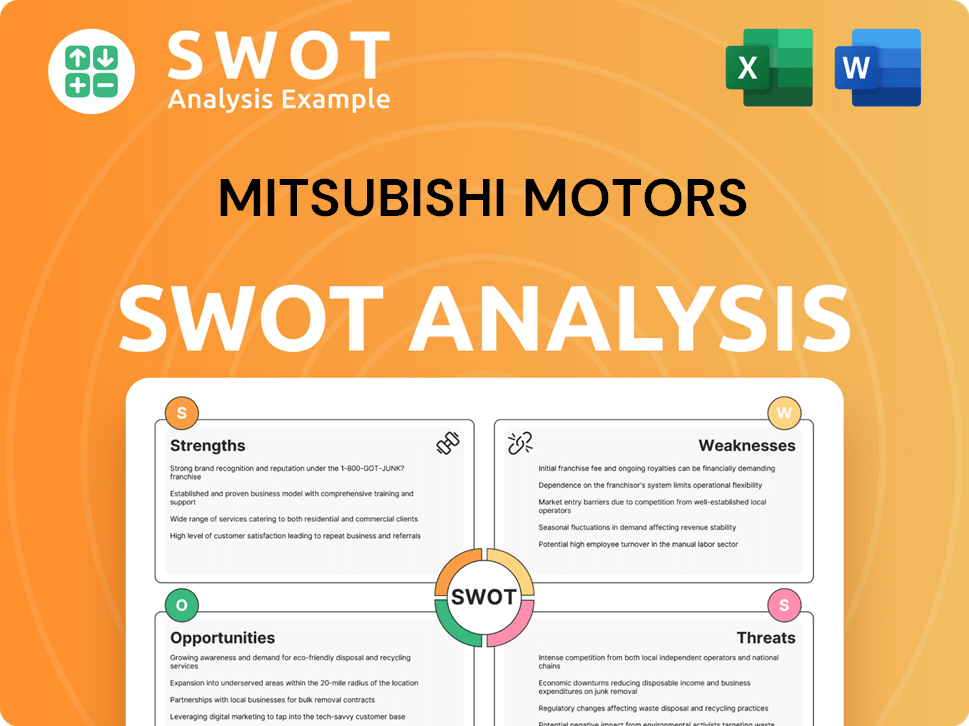
What Drove the Early Growth of Mitsubishi Motors?
The early growth and expansion of Mitsubishi Motors laid the foundation for its future in the automotive industry. The company's journey began with the introduction of the Mitsubishi Model A in 1917, marking its initial foray into car manufacturing. This early phase was characterized by a gradual increase in production and a focus on commercial vehicles, which were vital for Japan's infrastructure development.
Mitsubishi's initial steps in the automotive industry involved the hand-built Model A, which was primarily for government officials. The company then concentrated on commercial vehicles, such as trucks and buses, during the 1930s. Prototypes like the PX33, a four-wheel-drive sedan, demonstrated early technological innovation. This period set the stage for future developments.
After World War II, the Mitsubishi zaibatsu was dissolved, leading to the formation of independent entities. These entities, including Mitsubishi Heavy Industries, re-entered the automotive sector. They produced scooters, three-wheeled trucks, and small cars. This post-war period saw a gradual increase in vehicle production as Japan's economy recovered.
A pivotal moment occurred in 1964 when Mitsubishi Heavy Industries consolidated its automotive production by creating Mitsubishi Motors Corporation. This move streamlined operations and focused development. The 1960s also saw the beginning of Mitsubishi's international expansion, initially through exports to Southeast Asia. This expansion was a key part of the Mitsubishi history.
The early growth of Mitsubishi Motors involved a steady increase in production volume and technological advancements. The company focused on both domestic and international markets. This strategic approach helped establish Mitsubishi as a significant player in the Japanese car manufacturer landscape. For more insights, see the Growth Strategy of Mitsubishi Motors.
Mitsubishi Motors PESTLE Analysis
- Covers All 6 PESTLE Categories
- No Research Needed – Save Hours of Work
- Built by Experts, Trusted by Consultants
- Instant Download, Ready to Use
- 100% Editable, Fully Customizable
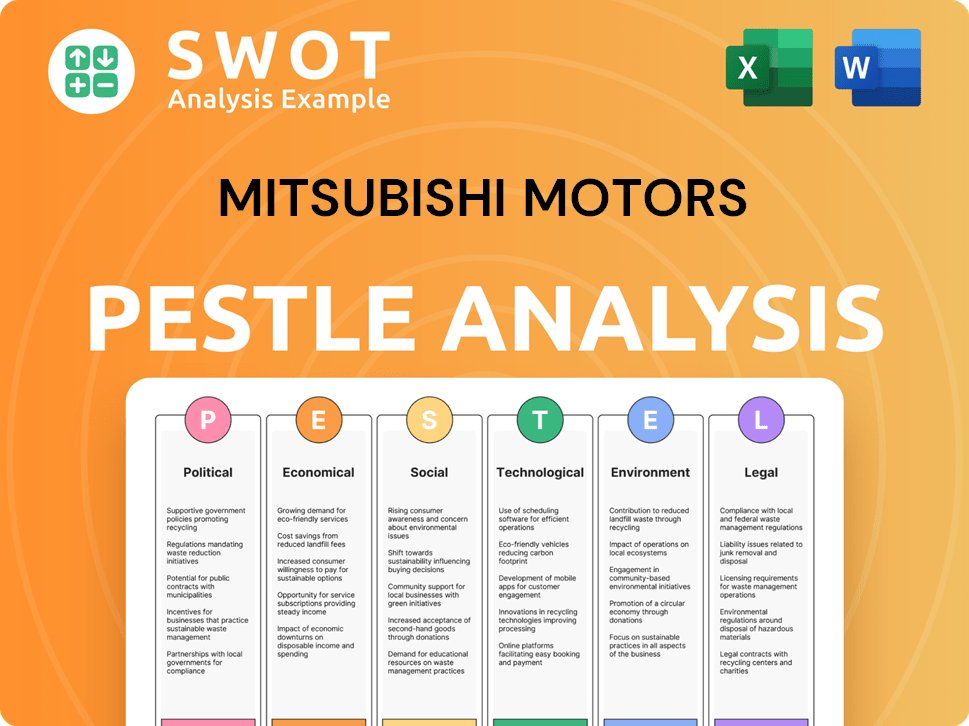
What are the key Milestones in Mitsubishi Motors history?
The Mitsubishi Motors journey is marked by significant milestones, from its inception as a Japanese car manufacturer to its global presence today. The company's history reflects its adaptability and resilience within the automotive industry, navigating both successes and challenges to establish a lasting legacy.
| Year | Milestone |
|---|---|
| 1917 | Introduction of the Mitsubishi Model A, Japan's first series-production automobile. |
| Post-War Era | Gained renown for robust commercial trucks and buses, vital for Japan's rebuilding. |
| 1970s | Established a partnership with Chrysler Corporation, expanding internationally. |
| 1982 | Launched the Pajero (Montero), an SUV icon, achieving success in off-road rallying. |
| 2009 | Launched the i-MiEV, one of the world's first mass-produced electric cars. |
| 2013 | Introduced the Outlander PHEV, a successful plug-in hybrid SUV. |
| 2016 | Became part of the Renault-Nissan-Mitsubishi Alliance. |
Innovation has been a core aspect of the Mitsubishi Motors history. The company has consistently pushed boundaries in automotive technology, from engine design to electric vehicle development.
The Silent Shaft engine, introduced in the 1970s, significantly reduced vibrations in four-cylinder engines, enhancing the driving experience. This innovation showcased Mitsubishi's commitment to improving engine performance and refinement.
The Pajero (Montero) became a global icon in the SUV segment, demonstrating Mitsubishi's ability to create successful, versatile vehicles. Its off-road prowess and rally victories further solidified its reputation.
The i-MiEV, launched in 2009, was one of the first mass-produced electric cars, marking Mitsubishi's early entry into the EV market. This initiative reflected the company's forward-thinking approach to sustainable mobility.
The Outlander PHEV, introduced in 2013, has been a consistent best-seller in its segment in several European markets. It combines electric and gasoline power, offering a practical and efficient solution for drivers.
In 2024, Mitsubishi continues to invest in EV technology, with the Outlander PHEV remaining a key model. The company is focused on improving battery technology and expanding its EV lineup to meet growing demand.
Mitsubishi has integrated ADAS features, such as adaptive cruise control and lane departure warning, into its vehicles. These systems enhance safety and improve the driving experience, reflecting the company's commitment to technological advancements.
Throughout its history, Mitsubishi Motors has faced numerous challenges. These challenges have tested the company's resilience and required strategic adjustments.
The 2000s were marked by vehicle defects and cover-ups, significantly damaging the company's reputation and sales. These issues led to financial losses and the need for restructuring, impacting consumer trust.
Mitsubishi faced intense competition from larger global automakers, necessitating strategic shifts in product development and market focus. The company had to adapt to changing consumer preferences and technological advancements to stay competitive.
Financial struggles led to the need for restructuring, including cost-cutting measures and strategic partnerships. The company has focused on improving its financial performance and streamlining operations.
The alliance provided much-needed financial stability and access to shared technologies. This collaboration has been crucial for Mitsubishi's recovery, enabling cost efficiencies and collaborative development in electrification and autonomous driving.
Mitsubishi has adapted its product lineup to meet evolving market demands, with a focus on SUVs and electric vehicles. The company's strategy includes expanding its presence in key markets, such as Southeast Asia and Europe.
Global economic conditions, including supply chain disruptions and inflation, have impacted Mitsubishi's operations. The company has taken steps to mitigate these challenges, such as optimizing production and managing costs.
Mitsubishi Motors Business Model Canvas
- Complete 9-Block Business Model Canvas
- Effortlessly Communicate Your Business Strategy
- Investor-Ready BMC Format
- 100% Editable and Customizable
- Clear and Structured Layout
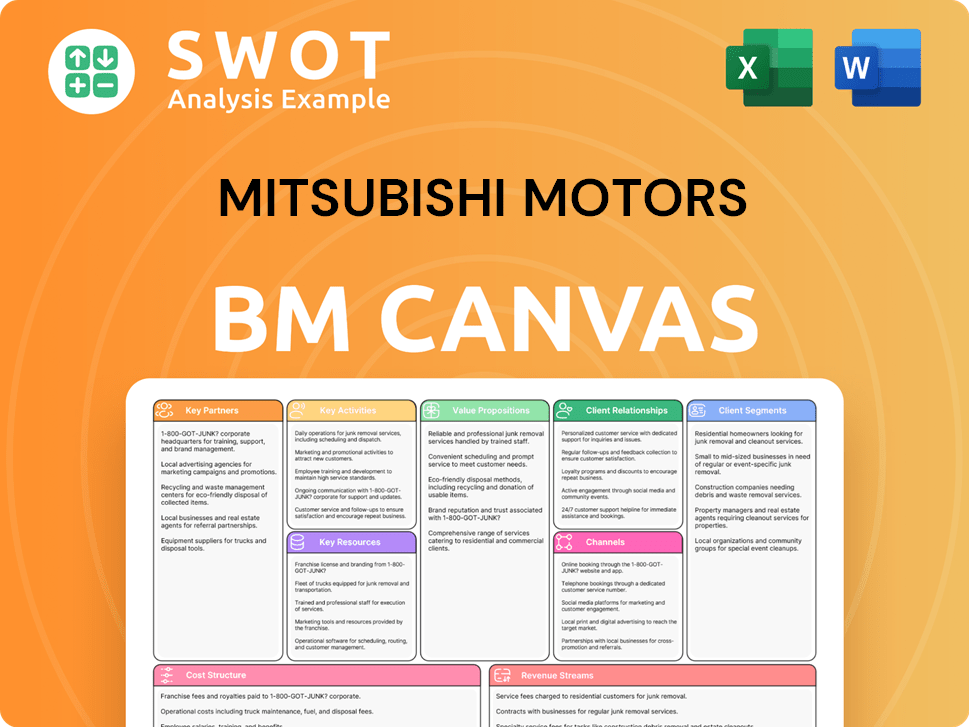
What is the Timeline of Key Events for Mitsubishi Motors?
The Marketing Strategy of Mitsubishi Motors is rooted in a rich history marked by significant milestones. From its shipping origins in 1870, established by Yataro Iwasaki, to the introduction of Japan's first series-production automobile in 1917, the
| Year | Key Event |
|---|---|
| 1870 | Yataro Iwasaki establishes the first Mitsubishi company, a shipping firm. |
| 1917 | Mitsubishi Shipbuilding Co., Ltd. introduces the Mitsubishi Model A, Japan's first series-production automobile. |
| 1937 | Development of the PX33, a prototype four-wheel-drive sedan. |
| 1946 | The Mitsubishi zaibatsu is dissolved, leading to the formation of independent companies. |
| 1964 | Mitsubishi Heavy Industries consolidates its automotive production into the Mitsubishi Motors Corporation division. |
| 1970 | Mitsubishi Motors Corporation is formally established as an independent company. |
| 1970s | Introduction of the Silent Shaft engine technology. |
| 1982 | Launch of the Mitsubishi Pajero/Montero SUV. |
| 2009 | Introduction of the i-MiEV, one of the world's first mass-produced electric vehicles. |
| 2013 | Launch of the Outlander PHEV, a highly successful plug-in hybrid SUV. |
| 2016 | Mitsubishi Motors joins the Renault-Nissan-Mitsubishi Alliance. |
| 2024 | Mitsubishi Motors continues to focus on electrification, aiming for 50% of global sales to be electric vehicles by 2030. |
The
The company is strategically focusing on strengthening its presence in the ASEAN region, which accounts for approximately 25% of its global sales volume. This region is a key growth area for the
Mitsubishi plans to introduce nine new models by 2025, including electrified vehicles. This expansion aims to bolster its product lineup and meet evolving market demands within the
The alliance with Renault and Nissan is crucial for sharing platforms, technologies, and production capabilities. This collaboration is vital for achieving ambitious electrification and growth targets, as noted by analysts.
Mitsubishi Motors Porter's Five Forces Analysis
- Covers All 5 Competitive Forces in Detail
- Structured for Consultants, Students, and Founders
- 100% Editable in Microsoft Word & Excel
- Instant Digital Download – Use Immediately
- Compatible with Mac & PC – Fully Unlocked
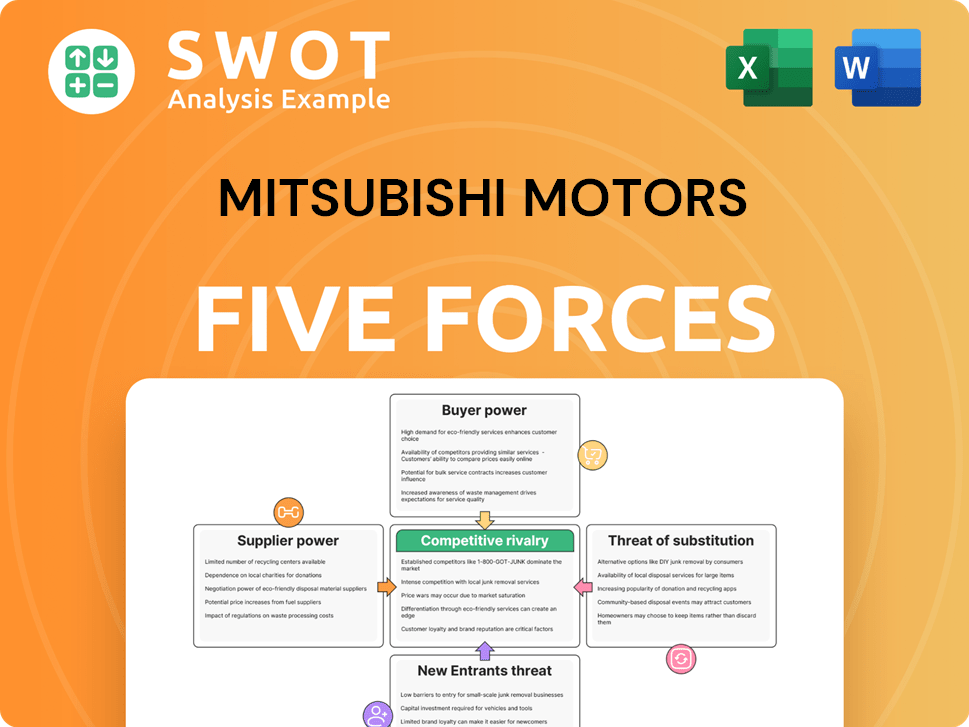
Related Blogs
- What is Competitive Landscape of Mitsubishi Motors Company?
- What is Growth Strategy and Future Prospects of Mitsubishi Motors Company?
- How Does Mitsubishi Motors Company Work?
- What is Sales and Marketing Strategy of Mitsubishi Motors Company?
- What is Brief History of Mitsubishi Motors Company?
- Who Owns Mitsubishi Motors Company?
- What is Customer Demographics and Target Market of Mitsubishi Motors Company?
Disclaimer
All information, articles, and product details provided on this website are for general informational and educational purposes only. We do not claim any ownership over, nor do we intend to infringe upon, any trademarks, copyrights, logos, brand names, or other intellectual property mentioned or depicted on this site. Such intellectual property remains the property of its respective owners, and any references here are made solely for identification or informational purposes, without implying any affiliation, endorsement, or partnership.
We make no representations or warranties, express or implied, regarding the accuracy, completeness, or suitability of any content or products presented. Nothing on this website should be construed as legal, tax, investment, financial, medical, or other professional advice. In addition, no part of this site—including articles or product references—constitutes a solicitation, recommendation, endorsement, advertisement, or offer to buy or sell any securities, franchises, or other financial instruments, particularly in jurisdictions where such activity would be unlawful.
All content is of a general nature and may not address the specific circumstances of any individual or entity. It is not a substitute for professional advice or services. Any actions you take based on the information provided here are strictly at your own risk. You accept full responsibility for any decisions or outcomes arising from your use of this website and agree to release us from any liability in connection with your use of, or reliance upon, the content or products found herein.